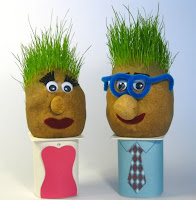1. Porcupine Potato Planter
WHAT YOU NEED:
o A potato
o 2 coloured drawing pins
o 4 golf tees
o Soil
o Grass or bird seed
o Spoon
o Scissors
o Pipe cleaner
WHAT YOU DO:
- Choose a potato
with one pointed end.
- Scoop out the
top of the potato with a spoon; leave a shell of about 15mm thick
- Press the drawing pins into the pointed end for
eyes.
- Twist a short piece of pipe cleaner and press it
into the rear for a tail.
- Push the 4 golf
tees into the bottom of the potato for legs.
- Fill the opening
at the top with soil & sprinkle seeds over the top of the soil.
- Water regularly
and your porcupine should grow "bristles" within 10 days.
- YOU CAN ALSO MAKE THESE POTATO PEOPLE WITH BIRD SEED HAIR!
WHAT YOU NEED:
o Sheet of coarse sandpaper
o Cardboard
o Glue
o Coloured wool
WHAT YOU DO:
- Glue the sheet
of sandpaper to the cardboard
- Using coloured
wools, make an outline picture.
(The wool will stick!)
- When you are
ready to make a new picture, pull the wool away from the sand-paper and
make a new one!
3. Sewing Pictures
WHAT YOU NEED:
o Thin cardboard
o Coloured wools
o Magazine picture
o Paints or crayons
o Pins
o Nail
o Scissors
o Darning needle
WHAT YOU DO:
- Use a magazine
picture with a large, simple outline.
- Pin the picture
onto the cardboard.
- Punch
evenly-spaced holes around the picture outline and through the cardboard with the nail.
- Remove the pins
and the picture.
- Thread the
needle with wool and sew in and out of the holes of the outline.
- Colour and
decorate the picture.
- Make two holes
at the top and thread a piece of wool through it for hanging.
4. Juggling Bags
o Juggling is a fun way to develop those advanced gross motor skills.
o Your child will develop patience, tenacity, and, together with a friend,
good competitive spirit!
WHAT YOU NEED:
o Cotton fabric (scraps will do!)
o Uncooked green lentils
o Scissors
o Needle and cotton.
WHAT TO DO:
For
each juggling bag: (We suggest you make at least three!)
o Cut a rectangle of fabric 10cm x 20cm.
o Fold in half, right sides together.
o Sew the two side seams together with small stitches.
o Turn the bag right side out.
o Fold the rough edge inside (about 1cm).
o Fill to about half with green lentils.
o Close the bag into a triangular shape by bringing the two side-seam ends
together.
o Sew the open edge closed with small stitches.
The lentils will give your juggling bags some weight
and make them easy to grip. Have fun!
5. Make A Guessing Box.
A Guessing Box, filled with interesting items with
different shapes and textures, is a great competitive game to play at parties.
WHAT YOU NEED:
o A large shoebox (or any similar sized box).
o A circular object to draw around.
o Pencil.
o Scissors.
o Material scrap (for the curtain).
o Sticky tape.
o Black paint
o Glue
o Glitter
WHAT TO DO:
o Use the circular object to draw a hole big enough for you hand to go
through.
o Cut out the hole.
o Paint the outside of the box and the lid, black.
o Cut two small rectangles of material for curtains to cover the hand
hole.
o Stick your curtains to the inside of the box with sticky tape.
o Decorate the outside of the box with glitter.
HOW TO PLAY:
o Fill your box with things like: a seed pod, a plastic spider, a pair of
sunglasses, a sponge, a wet cloth, a ball of wool, a metal pillbox, a marble, a
lump of play dough, a pine cone, a carrot.
o Take turns to use your imaginations to guess what is in the box, by
touch only.
o Have fun!








